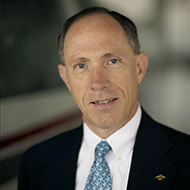A witness reported: "The Cessna 172 landed long and fast on Runway 19 (about halfway down the field). The aircraft hit nose first (slightly) and bounced two more times, then overshot the runway and fell down the ravine. The wind had been favoring Runway 19 but very suddenly swung around to favor Runway 01...." Winds from nearby reporting stations were variable from 130 degrees to 020 degrees at around eight knots.
Another witness reported: "The aircraft was attempting to land but was landing downwind at very high speed for final and flaps (in the) full up position. Aircraft began porpoising at end of runway and went over the guard rail into gorge...."
There was only 50 feet of grass overrun at the end of the runway. Beyond that was a road and a guard rail. The terrain beyond the road sloped down to a creek, about 100 feet below the level of the runway. In other words, this airport environment could be considered unforgiving.
The airplane settled into trees at the bottom of the ravine, and both wings were sheared off. A post-crash fire destroyed the fuselage.
The pilot reported: "I was practicing takeoffs and landings on Runway 19. I inadvertently extended only minimal flaps and therefore landed fast. A sudden wind change compounded this situation. I was unable to stop, porpoised three times, ran off the end of the runway, and the aircraft fell down a ravine that borders the airport to the south...." The pilot's total time was 104 hours, including 30 hours as pilot in command and seven hours in the make and model aircraft he was flying.
There are several lessons to be learned from this accident. The pilot stated that he forgot to use flaps or used "minimal flaps." With a field this short, flaps sure improve the odds of getting the aircraft down and stopped. Checklists have been known to help, and flap use is basic to the landing configuration.
A cardinal rule that every student should know and be tested on is to go around immediately if the aircraft is not on the ground in the first third of the runway. Students should practice this with a CFI but shouldn't need prompting to initiate the go-around. On a short strip with obstacles this is critical. Recovering from bounces is also something students and new pilots should practice with a CFI. In most cases, a go-around is easier to accomplish than a finessed save. If the pilot can't get the flare right the first time and the runway is short, he or she should cut the losses - immediately.
Shifty winds aren't always available in training, so students don't get to practice the decision-making that accompanies them. When new pilots do get their first taste of rapidly changing winds, they may be perplexed because the exact same control inputs that result in one perfectly executed approach may not work just moments later. Many students can't figure it out and will doggedly pursue the impossible dream. Going around if the landing is not accomplished in the first third of the runway is their salvation.
The accident report did not say what the instructor's relationship was with the student. Had they flown together before? Was the CFI aware of any weaknesses? If the pilot is unknown to the CFI, a more thorough look is needed, and we should be cautious when inheriting students. Very low time in aircraft type is also a typical precursor to problems. Obviously, changing wind conditions were the catalyst for this mishap, but the root of the problem was deeper.
Bruce Landsberg is executive director of the AOPA Air Safety Foundation.



